child seat Citroen C1 2016 1.G Owner's Manual
[x] Cancel search | Manufacturer: CITROEN, Model Year: 2016, Model line: C1, Model: Citroen C1 2016 1.GPages: 269, PDF Size: 7.63 MB
Page 5 of 269

.
C1_en_Chap00a_sommaire_ed01-2016
Exterior lighting control stalk 98
Automatic illumination of headlamps
1
01
Direction
indicators
1
03
Headlamp
beam height adjustment
1
03
Wiper
control stalk
1
04
Lighting and v isibility
Horn 10 6
Hazard warning lamps
1
06
ESC
system
1
07
Active
City Brake
1
10
Seat
belts
1
15
Airbags
1
18
Child
seats
1
23
Deactivating the passenger's front airbag 126
ISOFIX
child
seats
1
32
Child
lock
1
37
Safety
In
t
he
e
vent
o
f
a
b
reakdown
Fuel tank 138
Snow chains
1
40
Electrical
energy economy mode
1
41
Accessories
1
42
Changing
a wiper blade
1
44
Fitting
roof bars
1
44
Bonnet
14
6
Petrol
engines
1
47
Checking
levels
1
48
C h e c ks
1
51
Practical information Technical da ta
7-inch touch screen tablet 185
Audio system
2
35
Audio and telematics
Alphabetical
in
dex
Temporary puncture repair kit 1 53
Spare wheel
1
58
Changing
a bulb
1
63
Changing
a fuse
1
68
12
V battery
1
77
Towing
the vehicle
1
80Engines
1
81
Weights
1
82
Dimensions
1
83
Identification
ma
rkings
1
84
Contents
Page 7 of 269
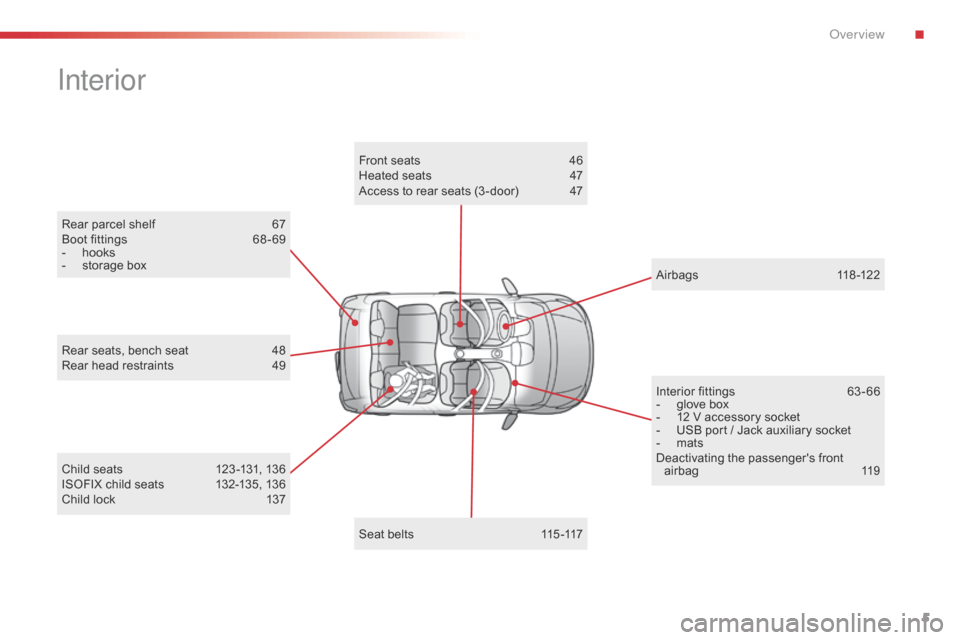
5
C1_en_Chap00b_vue-ensemble_ed01-2016
Rear parcel shelf 67
Boot fittings 6 8 - 69
-
h
ooks
-
s
torage box
Interior
Child seats 1 23 -131, 136
ISOFIX child seats 1 32-135, 136
Child
lock
1
37
Rear
seats, bench seat
4
8
Rear head restraints
4
9
Interior fittings
6
3 - 66
-
g
love box
-
1
2 V accessory socket
-
U
SB port / Jack auxiliary socket
-
m
ats
Deactivating t he p assenger's f ront ai
rbag 1 19
Airbags
1
18-122
Seat belts
1
15 -117
Front
seats
4
6
Heated seats
4
7
Access to rear seats (3 -door)
4
7
.
Over view
Page 24 of 269
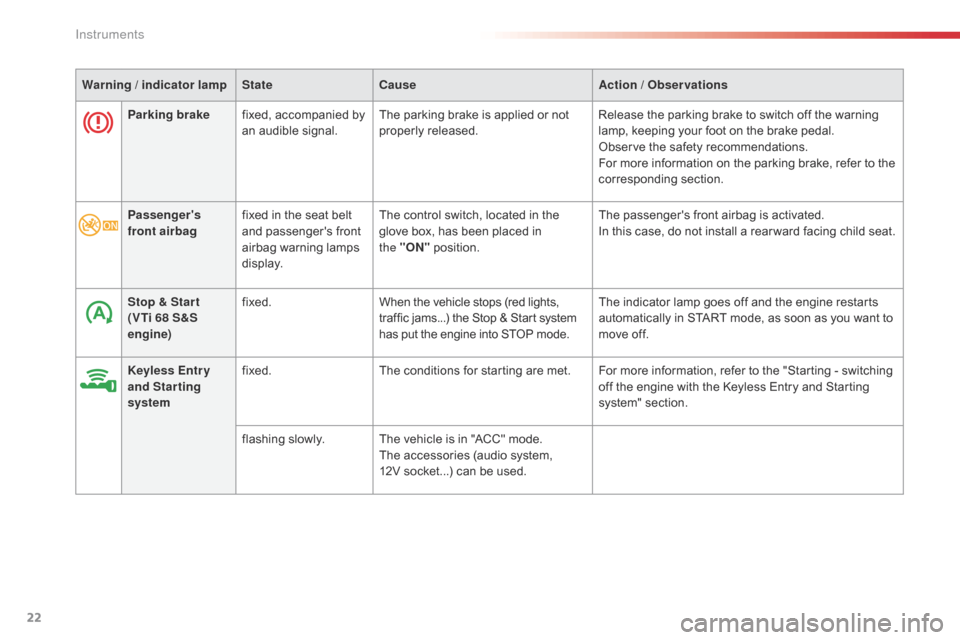
22
Parking brakefixed, accompanied by a
n audible signal.The
parking brake is applied or not p
roperly r eleased.Release
the parking brake to switch off the warning l
amp, keeping your foot on the brake pedal.
Observe
the safety recommendations.
For
more information on the parking brake, refer to the
c
orresponding
s
ection.
Warning
/ indicator lamp
State Cause Action
/ Observations
Passenger's
front airbag fixed
in the seat belt
a
nd passenger's front
a
irbag
w
arning
lam
ps
d
isplay. The
control switch, located in the
g
love box, has been placed in
t
he "ON"
p
osition.The
passenger's front airbag is activated.
In
this case, do not install a rear ward facing child seat.
Stop & Star t
(VTi 68 S&S
engine) fixed.
When
the vehicle stops (red lights,
t
raffic jams...) the Stop & Start system
h
as put the engine into STOP mode.The
indicator lamp goes off and the engine restarts
a
utomatically in START mode, as soon as you want to
m
ove off.
Keyless Entr y
and Starting
system fixed.
The
conditions for starting are met. For more information, refer to the "Starting - switching
o
ff the engine with the Keyless Entry and Starting
s
ystem" section.
flashing
s
lowly.The
vehicle is in "ACC" mode.
The
accessories (audio system,
1
2V socket...) can be used.
Instruments
Page 26 of 269
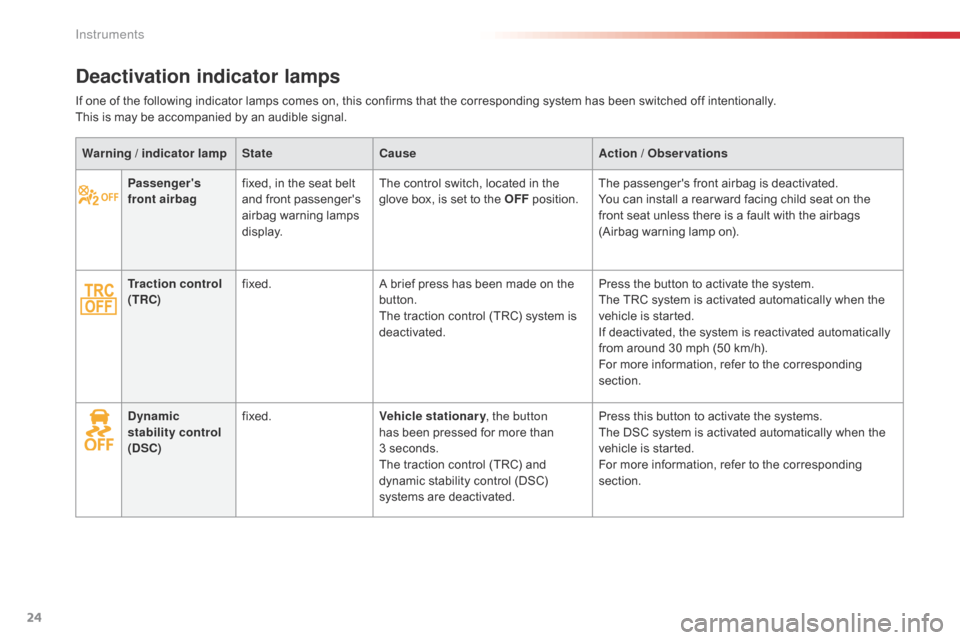
24
Passenger's
front airbagfixed,
in the seat belt a
nd front passenger's
a
irbag
w
arning
lam
ps
d
isplay. The
control switch, located in the g
love box, is set to the OFF p osition.The
passenger's front airbag is deactivated.
You can install a rear ward facing child seat on the
f
ront seat unless there is a fault with the airbags
(
Airbag warning lamp on).
Traction control
(TRC) fixed.
A
brief press has been made on the
b
utton.
The
traction control (TRC) system is
d
eactivated.Press
the button to activate the system.
The
TRC system is activated automatically when the
v
ehicle is started.
If
deactivated, the system is reactivated automatically
f
rom around 30 mph (50 km/h).
For
more information, refer to the corresponding
s
ection.
Dynamic
stability control
(DSC) fixed.
Vehicle stationary, the button
has
been pressed for more than
3 s
econds.
The
traction control (TRC) and
d
ynamic stability control (DSC)
s
ystems are deactivated.Press
this button to activate the systems.
The
DSC system is activated automatically when the
v
ehicle is started.
For
more information, refer to the corresponding
s
ection.
Warning
/ indicator lamp
State Cause Action
/ Observations
Deactivation indicator lamps
If one of the following indicator lamps comes on, this confirms that the corresponding system has been switched off intentionally.
T his is may be accompanied by an audible signal.
Instruments
Page 43 of 269

41
C1_en_Chap02_ouvertures_ed01-2016
Rear quarter windows
Opening
Closing
F Tilt the lever outwards.
F P ush it fully to secure the window in the
ope
n
p
osition.
F
P
ull the lever to release the window.
F
T
ilt the lever fully inwards to secure the
w
indow in the closed position.
On
the 5 -door versions, system for ventilation
o
f the rear seats by the partial opening of the
w
indow.
Front electric windows*
The driver has controls for both front w
indows.
The
electric windows do not work with
t
he ignition off.
1.
L
eft
hand
front
electric
window.
2.
R
ight
hand
front
electric
window.
After
the
ignition
has
been
switched
on,
press
o
ne of the control switches to open or pull to
close
the
window.
The
window
stops
when
you
r
elease
the
control
switch.
*
Depending
on
version. Closing
the windows can cause serious
in
jury.
Ensure
that nothing is preventing
t
he closing of the windows and take
p
articular care with children.
2
Access
Page 119 of 269
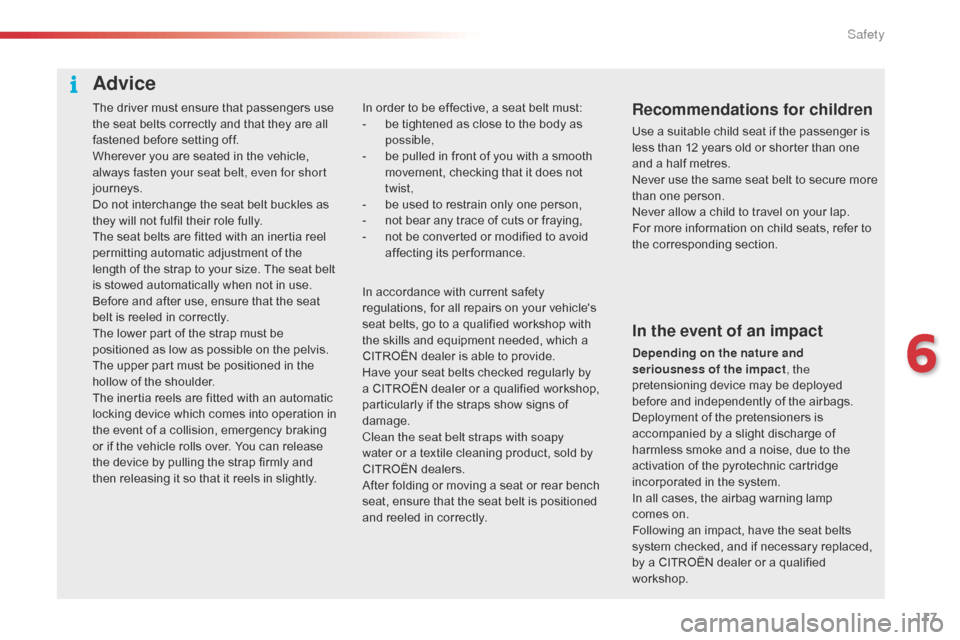
117
C1_en_Chap06_securite_ed01-2016
The driver must ensure that passengers use the seat belts correctly and that they are all
f
astened before setting off.
Wherever
you are seated in the vehicle,
a
lways fasten your seat belt, even for short
journeys.
Do
not interchange the seat belt buckles as
t
hey will not fulfil their role fully.
The
seat belts are fitted with an inertia reel
p
ermitting automatic adjustment of the
l
ength of the strap to your size. The seat belt
i
s stowed automatically when not in use.
Before
and after use, ensure that the seat
b
elt is reeled in correctly.
The
lower part of the strap must be
p
ositioned as low as possible on the pelvis.
The
upper part must be positioned in the
h
ollow of the shoulder.
The
inertia reels are fitted with an automatic
l
ocking device which comes into operation in
t
he event of a collision, emergency braking
o
r if the vehicle rolls over. You can release
t
he device by pulling the strap firmly and
t
hen releasing it so that it reels in slightly.Recommendations for children
Use a suitable child seat if the passenger is less than 12 years old or shorter than one
a
nd a half metres.
Never
use the same seat belt to secure more
t
han one person.
Never
allow a child to travel on your lap.
For
more information on child seats, refer to
t
he corresponding section.
In
order
to
be
effective,
a
seat
belt
must:
-
b
e
tightened
as
close
to
the
body
as
p
ossible,
-
b
e
pulled
in
front
of
you
with
a
smooth
m
ovement,
checking
that
it
does
not
t
wist,
-
b
e
used
to
restrain
only
one
person,
-
n
ot
bear
any
trace
of
cuts
or
fraying,
-
n
ot
be
converted
or
modified
to
avoid
a
ffecting
it
s
p
erformance.
In the event of an impact
Depending on the nature and
seriousness of the impact , the
pretensioning
device may be deployed
b
efore and independently of the airbags.
D
eployment of the pretensioners is
a
ccompanied by a slight discharge of
h
armless smoke and a noise, due to the
a
ctivation of the pyrotechnic cartridge
i
ncorporated in the system.
In
all cases, the airbag warning lamp
c
omes on.
Following
an impact, have the seat belts
s
ystem checked, and if necessary replaced,
b
y a CITROËN dealer or a qualified
w
orkshop.
In
accordance
with
current
safety
r
egulations,
for
all
repairs
on
your
vehicle's
s
eat
belts,
go
to
a
qualified
workshop
with
t
he
skills
and
equipment
needed,
which
a
C
ITROËN
dealer
is
able
to
provide.
Have
your
seat
belts
checked
regularly
by
a
CITROËN
dealer
or
a
qualified
workshop,
p
articularly
if
the
straps
show
signs
of
d
amage.
Clean the seat belt straps with soapy
water
or
a
textile
cleaning
product,
sold
by
C
ITROËN
dealers.
After
folding
or
moving
a
seat
or
rear
bench
s
eat,
ensure
that
the
seat
belt
is
positioned
a
nd
reeled
in
correctly.
Advice
6
Safety
Page 121 of 269

119
C1_en_Chap06_securite_ed01-2016
Deactivating the passenger's
front airbag
Only the passenger's front airbag can be deactivated.
F
W
ith the ignition off ,
insert the key in the
p
assenger airbag deactivation switch.
F
T
urn it to the "OFF"
p
osition.
F
R
emove the key keeping the switch in the
n
ew position.When
the ignition is on, this warning
l
amp comes in the seat belt and
p
assenger's front airbag display
s
creen. It stays on while the airbag is
d
eactivated. To
assure the safety of your child,
t
he passenger's front airbag must be
d
eactivated when you install a rear ward
f
acing child seat on the front passenger
sea
t.
Other wise, the child would risk being
s
eriously injured or killed if the airbag
w
ere deployed.
Reactivating the passenger's
front airbag
When you remove a rear ward facing child seat, w
ith the ignition off , turn the switch to the
"ON"
position to reactivate the airbag and so
a
ssure the safety of your front passenger in the
e
vent of an impact.
When
the ignition is switched on, this
w
arning lamp comes on in the seat
b
elt and passenger's front airbag
d
isplay screen. It stays on while the
f
ront airbag is activated.
Operating fault
Illumination of this warning lamp in the instrument panel indicates a fault
w
ith the airbags.
Contact
a
CITROËN dealer or a qualified
w
orkshop
without delay to have the system
c
hecked.
The airbags may no longer be
d
eployed
in the event of a serious impact.
In
this
case, do not install a child seat or seat
a
n
adult
on the front passenger seat.
6
Safety
Page 124 of 269

122
C1_en_Chap06_securite_ed01-2016
Sit in a normal upright position.
W ear a correctly adjusted seat belt.
Do
not leave anything between the
o
ccupants and the airbags (a child, pet,
o
bject...), nor fix or attach anything close to
t
he inflation trajectory of the airbags; this
c
ould cause injuries during their deployment.
Never
modify the original definition of your
v
ehicle, particularly in the area directly
a
round the airbags.
After
an accident or if the vehicle has been
s
tolen or broken into, have the airbag
s
ystems checked.
All
work on the airbag system must be
c
arried out by a CITROËN dealer or a
q
ualified
w
orkshop.
Even
if all of the precautions mentioned
a
re observed, a risk of injury or of minor
b
urns to the head, chest or arms when an
a
irbag is deployed cannot be ruled out. The
b
ag inflates almost instantly (within a few
m
illiseconds) then deflates within the same
t
ime discharging the hot gas via openings
p
rovided for this purpose.Front airbags
Do not drive holding the steering wheel by its spokes or resting your hands on the centre
p
art of the wheel.
Passengers
must not place their feet on the
das
hboard.
Do
not smoke as deployment of the airbags
c
an cause burns or the risk of injury from a
c
igarette or pipe.
Never
remove
or
pierce
the
steering
wheel
or
h
it it violently.
Do
not fit or attach anything to the steering
w
heel or dashboard, this could cause
i
njuries with deployment of the airbags.
Advice
Lateral airbags
Use only approved covers on the seats, compatible with the deployment the lateral
a
irbags. For information on the range of seat
c
overs suitable for your vehicle, you can
contact
a CITROËN dealer.
For
more information on accessories, refer
t
o the corresponding section.
Do
not fix or attach anything to the seat
b
acks (clothing...). This could cause injury
t
o the chest or arms if the lateral airbag is
d
eployed.
Do
not sit with the upper part of the body any
n
earer to the door than necessary.
Curtain airbags
Do not fix or attach anything to the roof. This could cause injury to the head if the curtain
a
irbag is deployed.
If
fitted on your vehicle, do not remove the
g
rab handles installed on the roof, they play
a
part in securing the curtain airbags.
For the airbags to be fully effective, observe the safety recommendations below:
Safety
Page 125 of 269
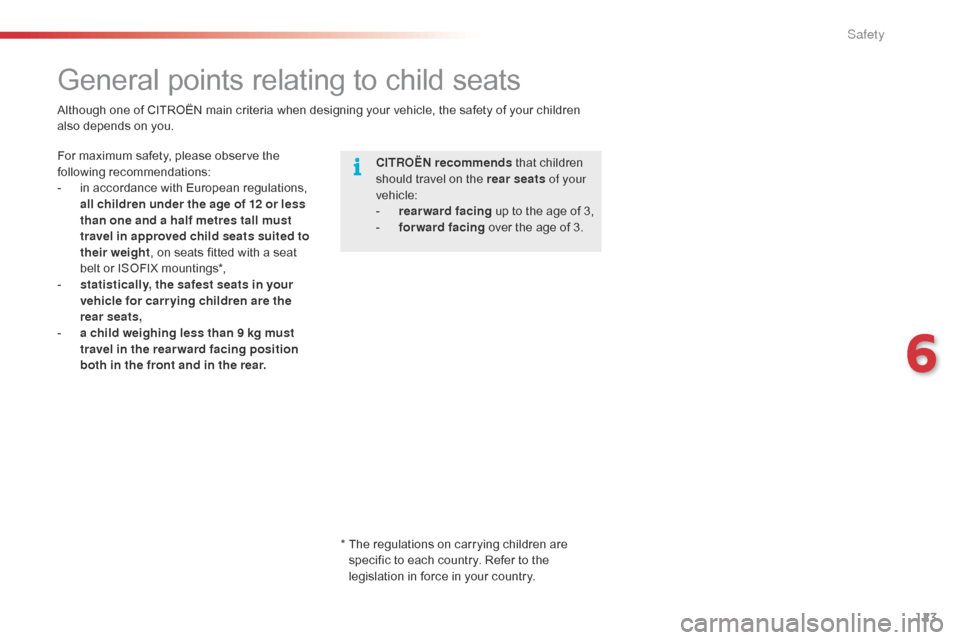
123
C1_en_Chap06_securite_ed01-2016
General points relating to child seats
CITROËN recommends that children s
hould travel on the rear seats of your
vehicle:
-
r
earward facing
up to the age of 3,
-
fo
rward facing
over the age of 3.
Although
one
of
CITROËN
main
criteria
when
designing
your vehicle, the safety of your children
a
lso
depends
on
you.
For
maximum
safety,
please
observe
the
f
ollowing r
ecommendations:
-
i
n
accordance
with
European
regulations,
a
ll children under the age of 12 or less
than one and a half metres tall must
travel in approved child seats suited to
their weight ,
on
seats
fitted
with
a
seat
b
elt
or
ISOFIX
mountings*,
-
s
tatistically, the safest seats in your
vehicle for carr ying children are the
rear seats,
-
a c
hild weighing less than 9 kg must
travel in the rearward facing position
both in the front and in the rear.
*
T
he
regulations on carrying children are
s
pecific to each country. Refer to the
l
egislation in force in your country.
6
Safety
Page 126 of 269
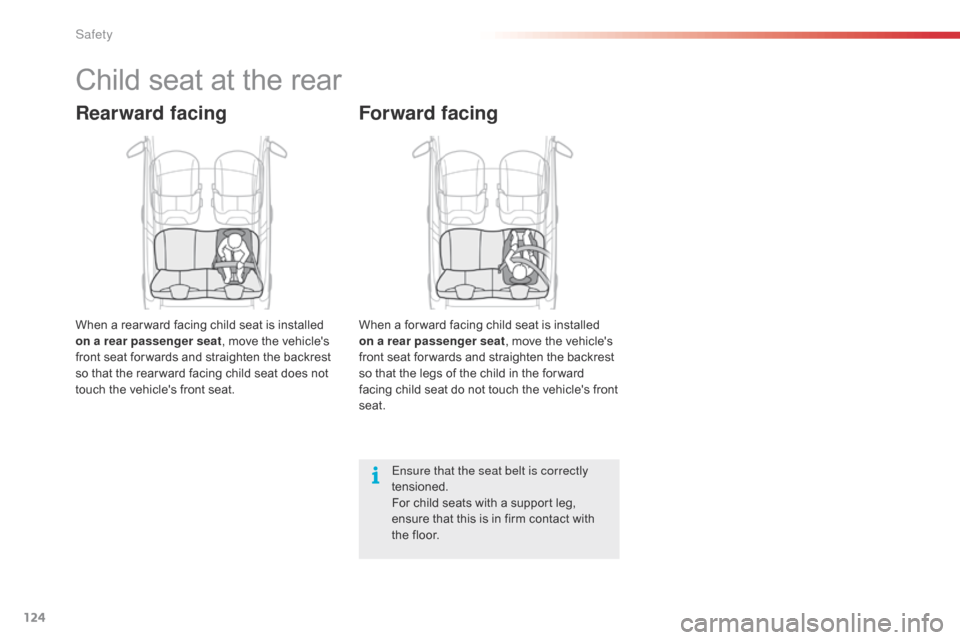
124
C1_en_Chap06_securite_ed01-2016
Child seat at the rear
Rearward facing
When a rear ward facing child seat is installed on a rear passenger seat ,
move the vehicle's
f
ront seat for wards and straighten the backrest
s
o that the rear ward facing child seat does not
t
ouch the vehicle's front seat.
Forward facing
When a for ward facing child seat is installed on a rear passenger seat ,
move the vehicle's
f
ront seat for wards and straighten the backrest
s
o that the legs of the child in the for ward
f
acing child seat do not touch the vehicle's front
sea
t.Ensure that the seat belt is correctly
tensioned.
For
child seats with a support leg,
e
nsure that this is in firm contact with
t
he floor.
Safety